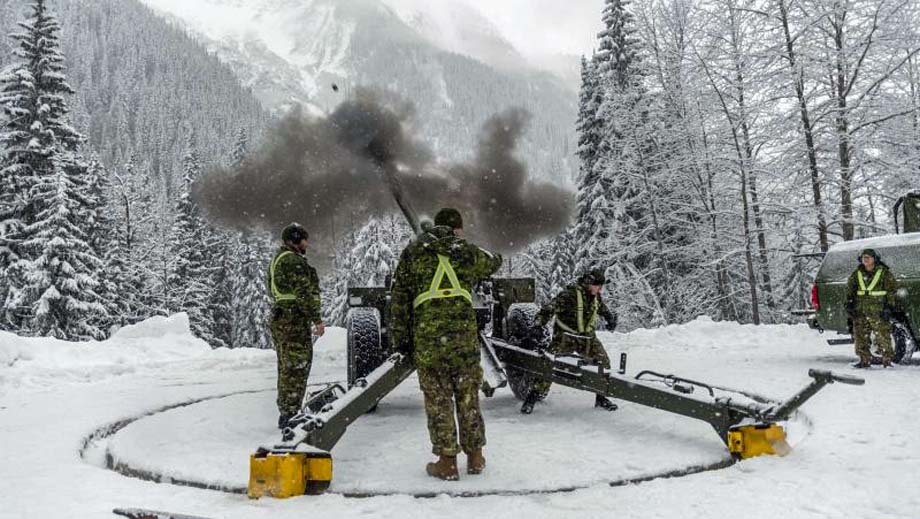
New York New York USA
Rogers Pass British Columbia - In the high mountain passes of southeastern British Columbia, the
Canadian military is mounting another winter offensive in its six-decade war against ice and snow.
This year's campaign comes at the close of an unusually deadly 2023 avalanche season in the western Canadian
backcountry.
The latest troop of artillery gunners arrived in Glacier National Park in mid-November with three 105 mm Howitzer field
guns trained on the narrow valley walls overlooking the Trans-Canada Highway and the Canadian Pacific
Railway.
The soldiers will remain on deployment into the new year when another rotation of troops will continue the work until
the fight is abandoned in late March or early April.
Canada's longest-running military operation began in 1961, the year before the Trans-Canada Highway fully
opened.
Every year since, dozens of soldiers and Parks Canada avalanche forecasters have trekked out to the area northeast of
Revelstoke to participate in Operation Palaci, the world's largest mobile avalanche-control program.
During a rotation change, there can be up to 50 Canadian Armed Forces members at the operation's main mountain
compound, an apartment-style complex that provides food and lodging for the mission.
From there, the soldiers set out to staff the guns from 18 designated firing positions, primarily located in Rogers
Pass, where the road and rail snake through the Selkirk Mountains in the most avalanche-prone travel corridor in North
America.
At more than 1,300 metres above sea level, Rogers Pass averages about 14 metres of snowfall per year and contains more
than 130 active avalanche paths crisscrossing the busy highway.
In the winter months, the federal government estimates up to 4,000 vehicles and 40 trains travel through the pass
daily.
It was here on 4 Mar 1910, that Canada's deadliest avalanche claimed the lives of 58 railway workers
claimed the lives of 58 railway workers tasked with clearing the tracks after an earlier
slide.
tasked with clearing the tracks after an earlier
slide.
It was here too, in 2003, that seven Grade 10 students from a private school south of Calgary died after they were
buried under a massive avalanche.
Seven other students and three teachers were swept up by the avalanche but survived.
Avalanche Closures Cost $500,000 per Hour
Today, Parks Canada officials close a section of the highway while the gunners blast away at the unsteady snowpack
before the shovels and ploughs come out to clear away the debris.
With 270 pre-designated targets already dialed in, the Howitzers can fire effectively at night and in all weather
conditions, hitting targets up to five kilometres away, Parks Canada says.
"Each shell is fired at a known trigger zone high up the slide path, creating a shockwave that releases an
avalanche when snow conditions are right," the agency says.
In a slow season, the gunners will fire between 300 and 500 high explosive shells into the mountainsides along the
40 kilometre corridor.
During a busy year, the fire count rises to more than 1,000 rounds, according to Pedram Mohyeddin, a spokesperson for
the Canadian Armed Forces.
Most highway closures for avalanche control last less than two hours, totalling around 100 hours of controlled closures
annually, Parks Canada says.
"Highway closures in this area have an estimated $500,000 per hour impact on Canada’s economy. The program
continues to evolve to reduce highway closure times and improve safety for the travelling public, staff, and partners
throughout the season," Mohyeddin said.
Approximately 2,000 avalanches are recorded along the Trans-Canada corridor through Rogers Pass each year, with about
120 of those slides affecting the highway, Parks Canada estimates.
Sixteen people have been killed by avalanches in Canada in 2023, surpassing the national average of 11 avalanche deaths
per year, according to Mary Clayton, a spokesperson with the Revelstoke-based Avalanche Canada.
Fourteen of those deaths were recorded in BC, including five deaths in three separate slides near Glacier National
Park.
Todd Coyne.
(likely no image with original article)
(usually because it's been seen before)
provisions in Section 29 of the
Canadian Copyright Modernization Act.
